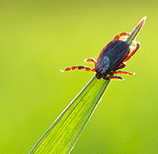Lyme disease is something you should know about, and Dr. Justine Lee is here to help. For more from Dr. Lee, find her on Facebook!
I've talked about what Lyme disease is and how to prevent it. Now, we’re going to focus on how to treat it and diagnose it accurately. Is Lyme disease treatable?
Is Lyme disease treatable?
If your dog tests positive for Lyme disease, or more importantly, is clinically sick from Lyme disease, then treatment includes an antibiotic called doxycycline (which often needs to be given for 4 weeks). While this is a relatively “safe” antibiotic, doxycycline can cause vomiting, esophagitis or reflux, sun-sensitivity, and permanent yellowing of puppy teeth – so make sure your dog really needs it before you give it!
As an FYI, you can help prevent side effects from doxycycline by doing the following:
- When administering the pill, give it in a small meatball, followed by your pet’s normal meal. This will help push the pill into the stomach, preventing the pill from sitting in the esophagus.
- Don’t give the pill right before your dog goes to bed – otherwise, if the pill is sitting in the esophagus (while your dog is lying down on his side), it can result in severe esophagitis.
- Keep your outdoor dog inside (so he’s out of the sun for long periods of time) while he’s on the medication, due to the rare risk of sun sensitivity (thankfully, dogs have fur, so are less likely to develop this side effect as compared to humans!).
- Don’t give this antibiotic with dairy products (e.g., in ice cream or yogurt), as it inactivates the antibiotic.
My general rule? If your dog has symptoms of Lyme, he should be treated. If he doesn’t have any symptoms and just happens to have a positive blood test for it, I don’t typically treat without doing more advanced tests (e.g., like a urine test measuring for protein or a specific quantitive C6 blood test…keep reading below to find out what these tests are!).
Diagnosing Lyme
There are a lot of Lyme blood tests out there nowadays, and it’s important to know how these tests work. One of the most common, effective ways is via an IDEXX SNAP® 4Dx® plus test, which your veterinarian can run immediately.

This test not only checks for heartworm, but it also tests for the following tick-born diseases: Borrelia burgdorferi (Lyme), Anaplasma phagocytophilum, Ehrlichia canis, Ehrlichia ewingii and Anaplasma platys. The test detects infection with the Lyme bacterium (via an antibody called C6), and this test isn’t affected by vaccine-induced antibodies. In other words, if your dog was vaccinated for Lyme disease, this test won’t falsely test positive just because of the vaccine, unlike the old tests out there.
Before the IDEXX SNAP 4Dx test became available, an IFA antibody test was commonly used to test for Lyme. This disadvantage of this test is that it is unable to differentiate between antibodies from vaccination, infection, and just exposure to the Lyme organism. Dogs who test positive on this test should be confirmed with a more specific test such as a quantitative C6 or Western Blot, both of which can tell if a positive result is from true infection or Lyme vaccination.
If your dog tests positive on the initial screening test, you can request a quantitative C6 test to find out more about your dogs infection. The quantitative C6 provides a measure of how high the antibodies are, which can tell you if the infection is active or, in a dog who has had Lyme infection in the past, if the infection has responded to treatment.
Keep in mind that in some areas of the country, only approximately 5-10% of dogs infected with Bb will develop clinical signs of the disease. So, just because your dog tests positive doesn’t mean you necessarily need to treat. When in doubt, check with your veterinarian to see if a course of doxycycline is necessary.
If your dog tests positive...
Relax. If this was done on the IDEXX SNAP 4Dx® Plus Test, it does mean that your dog was infected with the bacteria causing Lyme – but not that he has active, symptom-causing Lyme disease. Take the next step and get additional testing done (e.g., the quantitative C6 test) and a special urine test [urine protein creatinine (UPC)] to look for protein loss in the urine. If this is positive, your dog is showing symptoms of Lyme disease, or if your dog is a Goldie or Labrador, then yes – you should treat your dog. Otherwise, the positive test just means that at some point in his life, he’s been infected with the bacterium causing Lyme, and he may not need treatment.
If your dog is negative...
Chances are, your dog doesn’t have Lyme and doesn’t need to be treated. If your dog is still showing signs of shifting leg-lameness, fever, etc., your vet should hunt for something else going on, as it’s likely not due to Lyme – that is, unless it’s a very acute infection (and the body hasn’t had time to make antibodies to result in a positive test). Keep in mind that long-term treatment with doxycycline may eventually turn your dog’s test negative after a few months of treatment.
When in doubt, you want to have a healthy respect for this scary disease. Thankfully, it’s treatable! Check with your veterinarian on how and when to test for it. More importantly, focus on prevention, prevention, prevention! Tick-pick and use preventative care to avoid this potentially life-threatening infection to begin with.
<<Your Dog and the Dangers of Lyme Disease Part I
If you have any questions or concerns, you should always visit or call your veterinarian – they are your best resource to ensure the health and well-being of your pets.

